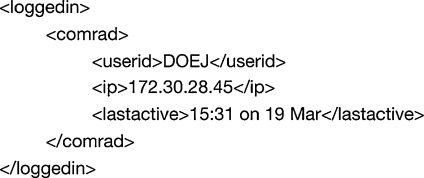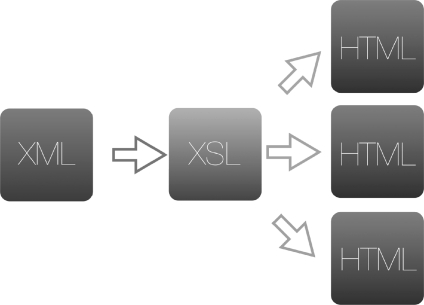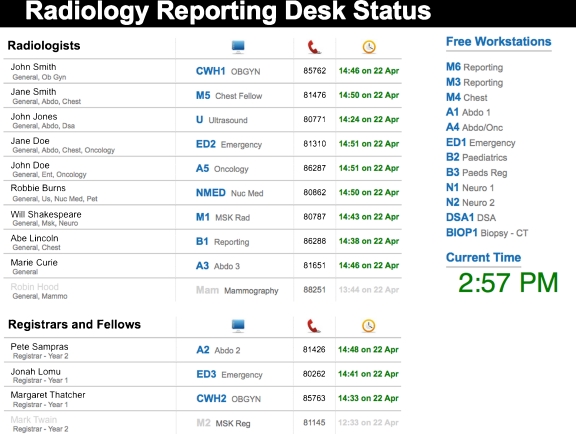Abstract
In radiology departments with multiple geographically separated reporting areas, locating radiologists can be challenging. We have developed an in-house solution to minimise the time spent looking for radiologists utilising near real-time data stored with our radiology information system (RIS). An auto updating Extensible Markup Language (XML) data feed from our RIS provider provides information about users logged into the RIS. It includes user names, their contact details and specialty interests, their location within the department, and a time stamp of last recorded dictation or report verification. The information is then displayed on our internal intranet and on a self-refreshing screen in our main department corridor. In order to estimate time savings made through the tools creation, usage statistics were calculated and combined with assessments of time taken to find a named radiologist prior to the tools implementation. Over the month of April 2009, there were 2,798 hits on the locator page. Radiologists were responsible for 1,248 hits and radiology administration staff for 1,550 hits. The average time for using the tool was calculated at 5 s. Reviewing a roster and calling/paging a radiologist took on average 30 s, and a full walk around of the department took 195 s. Through utilisation of near real-time data available within our RIS system and display of these data in an accessible form, we have developed a tool that has realised savings of up to 16 h of radiologist reporting time per week.
Key words: Real-time display, radiology information system, radiologist, clinical application, communication, data mining, extensible markup language (XML), internet technology, productivity, radiology information systems (RIS), web technology
Background
In large radiology departments with multiple geographically separated reporting areas, locating radiologists can be challenging. Referring to a roster, paging or phoning, or seeking radiologists out by searching reporting areas are all potentially time-consuming processes, which are in some instances disruptive to other radiologists working in reporting areas.
Over an entire radiology department, these time-consuming processes compound and introduce waste into a system that should be striving to provide a value-added service where the minimum amount of time essential to perform simple tasks should be the goal.
This article describes the development of an in-house solution to minimise time spent looking for radiologists. Although initially intended for use by radiologists to rapidly locate colleagues, it has subsequently been modified for use by radiology department administration staff and referring clinicians. The solution arose from an observation that the radiology information system (RIS) contained a record of all logged in radiologists and the details of the reporting terminal at which they were working.
Methods and Results
There are four major components to the system that has been created. These comprise new RIS components and modifications, an Extensible Markup Language (XML) feed1, an Extensible Stylesheet Language (XSL) style sheet2, and Hyper Text Markup Language (HTML) Web pages3. These were developed over an approximately 6-week time frame with three discrete phases.
The first phase of the solution involved obtaining an XML feed of data from our RIS provider (Comrad Medical Systems, Christchurch, New Zealand) as displayed below with example content (Fig. 1).
Fig 1.
Example of the initial XML feed with simple demographics for a logged in user.
The “last active” node in the data feed is an RIS time stamp that records the date and time of the last report dictation or verification event. This was felt to be the most reliable indicator of definite presence of a radiologist. At the reporting terminal, the RIS registered them as being logged in. As displayed above, this time stamp is reformatted to a human readable text string before export via the XML feed.
The second phase of the solution involved creation of a dynamic page on our departmental intranet, which radiologists could refer to when needing to locate colleagues. This was done using XSL transformation of the XML feed to an HTML page using PHP: Hypertext Preprocessor (PHP)4 (Fig. 2).
Fig 2.
Through XSL transformation, multiple Web pages can be created from a single XML data source.
The XSL style sheet allowed for the inclusion of additional metadata based on the unique < userid > nodes and < ip > nodes to accommodate useful information such as desk phone numbers and personal pager/cell phone numbers.
Once initial testing was complete, our RIS vendor began refreshing the XML feed initially once every 180 s, but subsequently shortened to 120 s once it was determined this could be done without adverse impact on the underlying database. Following transformation, the HTML page was published on an intranet, which is based on a modified version of the open source Wordpress publishing platform, running on a Debian Linux server within the hospital's internal network (Fig. 3).
Fig 3.
An example of the Web page displayed to clinicians.
Subsequent refinements to the XML feed have allowed for a substantially simplified XSL style sheet. Database fields within the RIS itself were utilised such as contact details and specialty interests. This allowed for creation of further nodes within the XML feed and easier maintenance of changes as these could be made within the RIS itself rather than requiring manual editing of the XSL files.
A further node < lastactiveminutesago > was later added to allow for dynamic styling of the HTML page to color code the time stamps depending on the quantity of time since activity by each specific radiologist, which was recorded.
To enable radiologists to indicate that they were undertaking tasks remote from their reporting terminal (such as procedures or clinical multidisciplinary meetings), a modification was made to the RIS giving a radiologist the ability to change their status and suspend display of the RIS time stamp in their “last active” field of the HTML page. The time stamp is replaced with the message, “AWAY FROM DESK” and can be easily toggled by the radiologist in the RIS front end. Displaying this status change in the HTML Web page was achieved through the addition of a final new node to the XML feed of < status >, which reads as HERE or AWAY.
The content of the expanded XML feed is summarized in Figure 4.
Fig 4.
An example of the more detailed XML feed with more detailed demographics for a logged in user.
At this point of the project, a duplicate stand-alone Web page outside of the intranet was made accessible to radiology administration staff.
The third and final phase of the project involved creation of an automatically refreshing modified version of the Web page intended for use by clinicians seeking a radiologist opinion. This page is displayed on a screen in the department's main corridor adjacent to a map of where the subspecialty reporting areas and individual reporting terminals are located. As this is a public area, rather than providing each individual radiologist's mobile phone and pager, the subspecialty areas of interest replace these details.
Although, subjectively, there was enthusiastic uptake, in particular, by radiologists and radiology administration staff, it was thought important to try and quantify the actual usage before pursuing any further refinements to the RIS.
The open source Webalizer statistics package5 was installed on the server providing the Web pages, and usage data was collected over a 1-month period.
The use of generic workstation logins precluded collection of individualised data. However, it was still possible to differentiate between use by the radiologist vs. radiology administration staff by recording respective hits on the separate intranet locator page and discrete administration page XSL files.
We undertook a number of process mapping exercises to ascertain the typical roster, pager and phone number lookup times, as well as the time involved in physically checking each reporting station for a required radiologist. These times were used to estimate how much radiologist and administration staff time has been saved per week since the introduction of the locator Web page.
Over the month of April 2009, there were 2,798 hits on the locator page. Radiologists were responsible for 1,248 hits and radiology administration staff for 1,550 hits.
Taking into account weekends and public holidays during this month, the average number of hits per working day was 62/day for radiologists and 77/day for administration staff.
The average time for using the tool was calculated at 5 s. Reviewing a roster and calling/paging a radiologist took on average 30 s, and a full walk around of the department took 195 s.
Assuming that every hit would have previously required using either review of the roster or a walk around the department, we estimate that for radiologists, the tool has saved between approximately 2.2 to 16 h of reporting time per week. For administration staff, the estimated time saved ranges between 2.8 and 20 h per week.
Due to the passive nature of viewing the automatically updating clinician screen, it is not possible to reliably estimate time saved by referring clinicians seeking radiologists or the reduction in interruptions experienced by administration staff (to assist with locating radiologists) and/or by reporting areas (due to clinicians and radiology staff searching for particular radiologists).
Discussion
For radiology departments to succeed in adding value to patient care, they must deliver their services in a timely manner. Spending anything other than the minimum amount of time essential to complete a task can be considered a form of waste in health care. We identified trying to locate radiologists was a source of wasted time for radiologists, other radiology department staff, and for referring clinicians, and we have developed a relatively simple solution that rapidly realised benefits in terms of time saved for those trying to locate radiologists and has also realised benefits from reducing interruptions to reporting areas related to the search processes.
Radiology departments are relatively unique with respect to having the majority of staff engaged in patient care, including radiologists, routinely utilising a common software application—a RIS. We have used this to our advantage, initially to assist radiologists with rapidly locating junior and senior colleagues, and then subsequently to assist other radiology department staff and referrers.
Through the results outlined, the system has increased the time available for the value-added services that our department provides by reducing wasted time. An additional benefit has been the increased visibility of the presence and location of our reporting radiologists to the wider hospital.
Despite initial concerns from our department's radiologists that the locator tool would increase interruptions and decrease productivity, paradoxically, there has been a subjective improvement in the reporting environment. Due to the hospital clinicians' ability to instantly identify whether the radiologist they are seeking is available, there has been a decrease in physical interruptions by a clinician randomly searching the department. Feedback from clinicians to the tool has been universally positive with consensus opinion that the ability to find preferred reporting radiologists for opinions and consults has increased the overall quality of these interactions.
A potential limitation of the RIS-based locator is that it is dependent on radiologists being logged in to the RIS. In our department, the majority of radiologists rostered to work will be engaged in diagnostic reporting and therefore logged in to the RIS. The minority group of radiologists rostered to be within the department but not logged in to the RIS will typically be undertaking procedural work or be absent from reporting areas participating in multidisciplinary meetings. Reverting to checking the roster and using pagers and mobile phones remains an option for locating those radiologists who are not using the RIS. Enabling radiologists to change their status to “AWAY FROM DESK” when undertaking tasks remote from reporting areas has enabled us to get around the problem of radiologists being logged in to the RIS but absent from where the locator suggests they should be.
Development of the locator was dependent on the cooperation of our RIS vendor with respect to provision of the refreshing XML data feed and on internal staff expertise to convert this feed to an easy-to-read Web page. The success of the locator page has seen the concept to be incorporated into the RIS development pathway by our vendor. In the future, the locator feature will be further integrated into the RIS front and back ends and be made available to other clients.
Conclusion
Through utilisation of near real-time data available within our RIS system and display of these data in an accessible form, we have developed a tool that has realised savings of up to 16 h of radiologist reporting time per week.
References
- 1.Bray T, Paoli J, Sperberg-McQueen CM, Maler E, Yergeau F. Extensible markup language (XML) 1.0 (Fifth Edition). World Wide Web Consortium (W3C) Web site. http://www.w3.org/TR/2008/REC-xml-20081126/ Accessed October 17, 2009.
- 2.The Extensible Stylesheet Language Family (XSL) World Wide Web Consortium (W3C) Web site. http://www.w3.org/Style/XSL/. Published Accessed October 17, 2009.
- 3.Hickson I, Hyatt D. HTML 5, A vocabulary and associated APIs for HTML and XHTML. World Wide Web Consortium (W3C) Web site. http://www.w3.org/TR/html5/. Accessed October 17, 2009.
- 4.The Php Group. PHP: Hypertext preprocessor. http://php.net/index.php. Accessed October 18, 2009.
- 5.Barrett B. Home of the Webalizer. http://www.mrunix.net/webalizer/. Accessed October 17, 2009.






